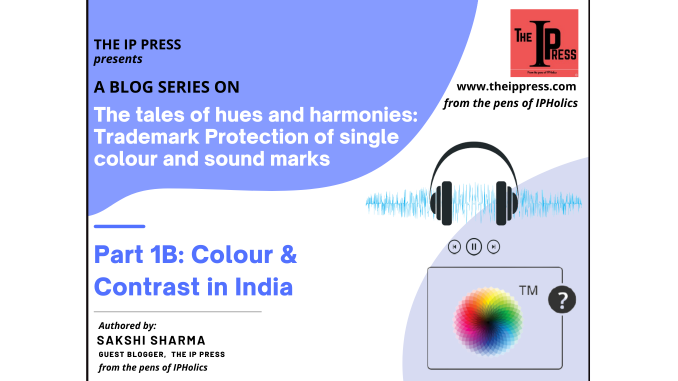
Part 1B: Colour & Contrast in India
Resuming our discussion on the golden bunny and legality of colours as trademarks, India is not oblivious to the concept of single colour trademarks (In continuation to the previous post-The Golden Hare and Monochromic affair. Of the trademarks mentioned previously, Tiffany & Company have an Indian registration (Application No. 4035753) for its robin egg blue box and Christian Louboutin has a registration (Application Nos. 2341894, 1922048) for its red shoe sole. Additionally, Ownes Corning, an insulation and roofing company based in USA has a registration for colour Pink (Pantone 210) in India (Application No. 1705585) since 2008. Much like the international arena, the Indian Trade Marks Act does not explicitly recognize single colour trademarks and the interpretation usually flows from section 2(1)(m) that provides for the definition of ‘marks’, section 2(1)(zb) that provides for the definition of ‘trademark’ (both of which explicitly provide for ‘combination of colours’) and section 10 that states “a trademark may be limited wholly or in part to any combination of colours and any such limitation is to be considered while deciding on the distinctive character of the trademark”. Additionally, the Manual of Trademarks – Practice & Procedure that is adhered to by the Indian Trademark Registry specifies that single colour trademarks are usually liable to be objected under Section 9(1)(a) of the Trade Marks Act, due to lacking capacity to distinguish. However, single colour trademarks may be registrable “if it is very unusual and peculiar in a trade and is recognized by traders and consumers alike that it serves as a badge of origin for that class of goods”.
Prism of Precedents
In the case of Colgate Palmolive Company v. Anchor Health & Beauty Care Pvt. Ltd., the issue before the Delhi High Court was concerning the unauthorized use of trade dress and colour combination of “red and white” on the packaging of tooth powder. The Court in this case, as early as 2003, observed that “significance of trade dress and colour combination is so immense that in some cases even single colour has been taken to be a trade mark to be protected from passing off action. Colour combination is a trade mark within the definition of the Trade Marks Act as there is no exclusion in the definition. Even a single colour has been held to be a trade mark. There may be exception also. Exception is that where the colour cannot be protected as the blue colour is for the Ink and red colour is for the lipstick.” However, the very same court took a different stance in the 2007 judgement of Cipla Limited v. M.K. Pharmaceuticals where the dispute was with respect to the defendant copying the colour of medicinal tablets and packaging of the plaintiff. The court had observed that “it was a settled law that there can be no monopoly over colours” and that medicines are purchased at the advice of doctors, sold on prescription and not on the basis of colour. It was held that “distinctiveness of medicines lies in the name and not in the colour and shape and neither can be associated with trademark”. It is likely that the reason for such an outcome was given in the nature of product – medicines, which are subjected to a higher level of scrutiny due to their effect on health & well-being of individuals as well as accessibility of the same. More recently, in the case of Marico Limited v. Mukesh Kumar, the Delhi High Court once again opined on single colour trademarks while deciding on the issue of passing off. The suit for infringement and passing off was filed by Marico Limited for the blue (Pantone 285C) coloured bottle & packaging with a flag label bearing the trademark ‘Parachute’, which is a popular hair oil. The court ruling that there was infringement and passing off, was of the view that the Plaintiff was not claiming monopoly over the single colour but the cumulative effect of the packaging, which is inclusive of the blue coloured bottle and had found this packaging to be novel, distinctive and acting as a source identifier.
A discussion on single colour trademarks would be incomplete without discussing a series of cases concerning Christian Louboutin’s red shoe sole. In the 2017 case of Christian Louboutin SAS v. Pawan Kumar (Pawan Kumar case), the Delhi High Court while dealing with an infringement claim and passing ex-parte orders against counterfeiters, held that in light of evidence, the red shoe sole trademark had acquired the status of a well-known mark. However, in the subsequent case of Christian Louboutin SAS v. Abubaker (Abubaker case), the very same court had held that single colour could not be adopted as a trademark as the legislature deliberately and intentionally used ‘combination of colours’ i.e. more than one colour and not the word colour in singular. The analogy relied on was that single colour is not recognized statutorily and hence, is not eligible as a mark much less a trademark. The court, infact, doubled down and said that even if the trademark is valid, other manufacturers and sellers are not prohibited from using the colour red on shoe soles as the colour serves as a non-trademark function i.e. it is a feature of the product/goods and the defence of section 30(2) can be relied on. Additionally, the court also held that the single colour trademark could not be registered as a device either and that applying a single colour to the sole of footwear would not result in making the single coloured sole a device. When reliance was placed on Pawan Kumar case, the judge was of the view that the same would not be applicable as the judgment does not take into consideration section 2(m) or section 30(2) [Limits on effect of registered trade mark] of the Trade Marks Act and would not have binding effect on account of ignoring the direct provision of law. The suit was dismissed at the first hearing stage. In July 2018, two months after the Abubaker case, the Delhi High Court once again faced the issue of infringement and passing off in Christian Louboutin SAS v. Ashish Bansal and it ruled in favour of the Plaintiff. The case makes no reference to the jurisprudence surrounding single colour trademarks or the case of Abubaker, merely relying on the valid registrations. An appeal was filed from the 2018 Abubaker judgement before the Division Bench of the Delhi High Court. While the division bench overruled the previous Abubaker case on procedural grounds, it did opine that defence of Section 30(2) cannot be utilized suo moto by the court and that in a suit for infringement, the presumption is that the mark is valid and registered, thereby declaring the exercise undertaken by the Single judge for invalidating ‘the red shoe sole’ trademark as uncalled for. Despite the overruling, the division bench did leave the quintessential question unanswered – are single colour trademarks not registrable as per Indian law and additionally, do colour marks have to exist as only combination of colours to be recognized and protected?
Chromatic Conclusion
Had the ‘Golden Lindt Bunny’ dispute been in consideration before an Indian court of law, it was very likely that the question of validity of single colour trademarks would once again be deliberated on. Much like our German counterparts, the Indian trademark law also allows for protection of unregistered trademark rights on the basis of renown and an Indian court would entertain the claim as that of a suit for passing off, in the absence of a trademark registration. The outcome, however, could sway either way. If significant weight is given to the precedents other than the Abubaker cases, it is likely that Lindt would succeed, especially relying on Marico Limited v. Mukesh Kumar wherein rights in the blue coloured bottle alongwith all contributing elements fo its packaging of hair oil was protected and the claim of passing off had succeeded. But with the Abubaker cases, there came more questions than answers. A possible alternative claim could be the claim of trade dress infringement, provided there were significant similarities between competitor’s and Lindt’s packaging that are beyond the use of just golden foil. The shape of the chocolate (in the form of bunny), the ribbon around the neck with a bell, the features of the bunny and the placement of the mark ‘Lindt’, would all be relevant factors to be considered then. The question of single colour trademarks though is one that would need some ‘infusing of colour’ of interpretation, either by means of a larger bench of court adjudicating on the same or by means of some legislative clarity.
That said, chocolatiers must not worry – there is no monopoly over ‘gold’ (yet), just over ‘gold bunnies’.
Link to the PART 1A of the article: https://www.theippress.com/2022/01/11/the-tales-of-hues-and-harmonies-trademark-protection-of-single-colour-and-sound-marks/

Sakshi Sharma
Author
Sakshi is a practicing Intellectual Property attorney who has worked as a litigation associate with a leading IP law firm. She has advised several national and international clients on contentious and non-contentious matters grounded in trademark, copyright, design and GI law and additionally, intersections of intellectual property law with advertising, consumer protection and information technology law. She is a graduate of Gujarat National Law University.
Very interesting, Wish to see much more like this. Thanks for sharing your information!